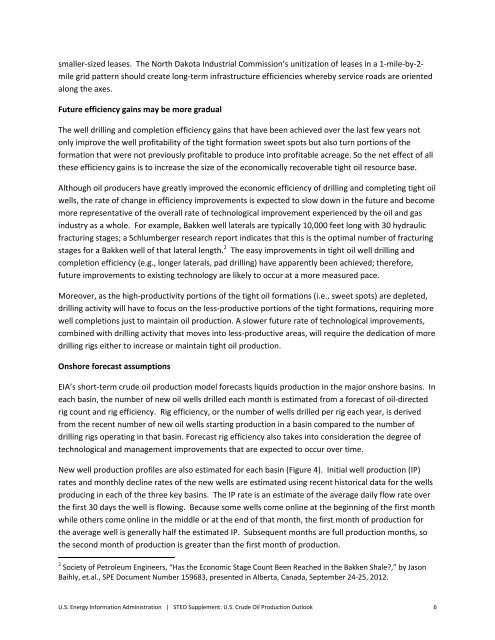Key drivers for EIA's short‐term US crude oil production outlook
Key drivers for EIA's short‐term US crude oil production outlook
Key drivers for EIA's short‐term US crude oil production outlook
You also want an ePaper? Increase the reach of your titles
YUMPU automatically turns print PDFs into web optimized ePapers that Google loves.
smaller‐sized leases. The North Dakota Industrial Commission’s unitization of leases in a 1‐mile‐by‐2‐<br />
mile grid pattern should create long‐term infrastructure efficiencies whereby service roads are oriented<br />
along the axes.<br />
Future efficiency gains may be more gradual<br />
The well drilling and completion efficiency gains that have been achieved over the last few years not<br />
only improve the well profitability of the tight <strong>for</strong>mation sweet spots but also turn portions of the<br />
<strong>for</strong>mation that were not previously profitable to produce into profitable acreage. So the net effect of all<br />
these efficiency gains is to increase the size of the economically recoverable tight <strong>oil</strong> resource base.<br />
Although <strong>oil</strong> producers have greatly improved the economic efficiency of drilling and completing tight <strong>oil</strong><br />
wells, the rate of change in efficiency improvements is expected to slow down in the future and become<br />
more representative of the overall rate of technological improvement experienced by the <strong>oil</strong> and gas<br />
industry as a whole. For example, Bakken well laterals are typically 10,000 feet long with 30 hydraulic<br />
fracturing stages; a Schlumberger research report indicates that this is the optimal number of fracturing<br />
stages <strong>for</strong> a Bakken well of that lateral length. 2 The easy improvements in tight <strong>oil</strong> well drilling and<br />
completion efficiency (e.g., longer laterals, pad drilling) have apparently been achieved; there<strong>for</strong>e,<br />
future improvements to existing technology are likely to occur at a more measured pace.<br />
Moreover, as the high‐productivity portions of the tight <strong>oil</strong> <strong>for</strong>mations (i.e., sweet spots) are depleted,<br />
drilling activity will have to focus on the less‐productive portions of the tight <strong>for</strong>mations, requiring more<br />
well completions just to maintain <strong>oil</strong> <strong>production</strong>. A slower future rate of technological improvements,<br />
combined with drilling activity that moves into less‐productive areas, will require the dedication of more<br />
drilling rigs either to increase or maintain tight <strong>oil</strong> <strong>production</strong>.<br />
Onshore <strong>for</strong>ecast assumptions<br />
EIA’s <strong>short‐term</strong> <strong>crude</strong> <strong>oil</strong> <strong>production</strong> model <strong>for</strong>ecasts liquids <strong>production</strong> in the major onshore basins. In<br />
each basin, the number of new <strong>oil</strong> wells drilled each month is estimated from a <strong>for</strong>ecast of <strong>oil</strong>‐directed<br />
rig count and rig efficiency. Rig efficiency, or the number of wells drilled per rig each year, is derived<br />
from the recent number of new <strong>oil</strong> wells starting <strong>production</strong> in a basin compared to the number of<br />
drilling rigs operating in that basin. Forecast rig efficiency also takes into consideration the degree of<br />
technological and management improvements that are expected to occur over time.<br />
New well <strong>production</strong> profiles are also estimated <strong>for</strong> each basin (Figure 4). Initial well <strong>production</strong> (IP)<br />
rates and monthly decline rates of the new wells are estimated using recent historical data <strong>for</strong> the wells<br />
producing in each of the three key basins. The IP rate is an estimate of the average daily flow rate over<br />
the first 30 days the well is flowing. Because some wells come online at the beginning of the first month<br />
while others come online in the middle or at the end of that month, the first month of <strong>production</strong> <strong>for</strong><br />
the average well is generally half the estimated IP. Subsequent months are full <strong>production</strong> months, so<br />
the second month of <strong>production</strong> is greater than the first month of <strong>production</strong>.<br />
2 Society of Petroleum Engineers, “Has the Economic Stage Count Been Reached in the Bakken Shale?,” by Jason<br />
Baihly, et.al., SPE Document Number 159683, presented in Alberta, Canada, September 24‐25, 2012.<br />
U.S. Energy In<strong>for</strong>mation Administration | STEO Supplement: U.S. Crude Oil Production Outlook 6
















